Abstract
This article describes a one-degree-of-freedom haptic device that can be applied to perform three different exercises for shoulder rehabilitation. The device is based on a force control architecture and an adaptive speed PI controller. It is a portable equipment that is easy to use for any patient, and was optimized for rehabilitating external rotation movements of the shoulder in patients in whom this was limited by muscle–skeletal injuries. The sample consisted of 12 shoulder rehabilitation sessions with different shoulder pathologies that limited their range of shoulder mobility. The mean and standard deviations of the external rotation of shoulder were 42.91 ± 4.53° for the pre-intervention measurements and 53.88 ± 4.26° for the post-intervention measurement. In addition, patients reported high levels of acceptance of the device. Scores on the SUS questionnaire ranged from 65 to 97.5, with an average score of 82.70 ± 9.21, indicating a high degree of acceptance. The preliminary results suggest that the use of this device and the incorporation of such equipment into rehabilitation services could be of great help for patients in their rehabilitation process and for physiotherapists in applying their therapies.
1. Introduction
Shoulder rotator cuff injuries include tendinopathies and partial or complete tendon ruptures, mostly related to the supraspinatus tendon [1]. Exercise is a key component of treatment for shoulder soft tissue injuries of the shoulder. Evidence recommends exercise-based interventions to reduce pain and increase shoulder function. Evidence also suggests that progressive shoulder strengthening and stretching are effective in the management of rotator cuff injuries [2]. Exercises should be introduced as early as possible. However, in clinical practice, the actual referral rate to physical therapists is low due to the lack of access to publicly funded physical therapy in health care systems [3]. Waiting for outpatient physiotherapy services has been shown to have mixed results in clinical and health system outcomes. The review by Deslauriers et al. [4] suggests the possible detrimental effects of waiting on pain, disability, quality of life, and psychological symptoms in people with shoulder disorders. There is also evidence of higher healthcare utilization and costs for patients who wait longer before physiotherapy services [4]. The effects of waiting caused by lack of access to physiotherapy services could be mitigated by the implementation of robotic devices with which more patients can be treated at the same time with a lower number of physiotherapists. Rehabilitation robots can significantly reduce the burden of therapists by providing repetitive and precise therapy to people with upper limb impairments over a long period of time [5].
Most upper extremity devices for rehabilitation available on the market are designed to improve flexion and abduction, and not external rotation, which is a fundamental movement in the performance of activities of daily living. Rotation movements are fundamental for performing activities below the horizontal and to execute coordinated movements with the hand for an individual to locate themselves in space [6]. In addition, most studies have been carried out in stroke patients [7,8]. This equipment is based on exoskeletons [9] or haptic devices [10]. The exoskeletons typically cover the arm and forearm and are linked to the trunk using flexible components. Meanwhile, haptic devices are attached to the hand to guide the movement while exerting force.
There is great interest in developing more specific equipment for rehabilitation [11]. This equipment is focused specifically on rehabilitation and solve the constraints of generic exoskeletons, particularly, the difficulties of supporting complex movements of joints such as the shoulder. The rigid exoskeletons use special mechanisms that increase its complexity. At the end, the goal is to adjust the actuated degree of freedom of the exoskeleton to the desired rotation plane of the shoulder/arm for each specific rehabilitation treatment. In some cases, textile or other flexible materials are used to avoid movement constraints.
This article describes a one-degree-of-freedom haptic device that can be applied to perform three different exercises for shoulder rehabilitation. This device implements force control behavior. This force control entails resistance to the patient’s shoulder rotation that is customized according to the patient’s status. Therefore, the same equipment can be adapted to the patient’s evolution and all session activities can be recorded for clinician studies. A portable and compact equipment has been designed for shoulder rehabilitation treatments.
2. Materials and Methods
For the present study, a pre- and post-treatment study was performed for an intervention session using a one-degree-of-freedom haptic device to perform three different exercises for shoulder rehabilitation.
2.1. Device
The rehabilitation device consists of the following components: the actuator, transmission components, force sensor, handle, and controller. The architecture used is shown in Figure 1. The actuator is based on a DC motor; the Maxon DCX22S has been selected for this application. Its rated operation is at 38 VDC, 5.9 Nm, and 10.5 revolutions per minute (RPM). This motor generates the required force that is applied to the patient. The controller calculates the reference value according to the desired force and information provided by sensors; then, the driver (H-bridge max14870) sets the power to the motor. The controller is run on a Texas Instruments board, specifically, the LAUNCHXL-F28379D model. This board contains a 32-bit dual-core TMS320F2-8379D microcontroller, which runs at 200 MHz. The controller closes the force control loop at 1 kHz. The transmission is made up of a cable and a pulley that transmit the actuator torque to the patient; the ratio between the motor and the pulley is 100:1 mm. A force sensor is located at the end of the cable and is also linked to the handle. The force sensor is implemented by a load cell manufactured by Futek, which is used to measure the force reflected by the motor. The sensor model used in this work is LSB205 connected to the Analogue Strain Gauge Signal Conditioner IAA100; it offers a load measurement range from 0 to 11 Kg, corresponding to 0 to 5 DC volts.
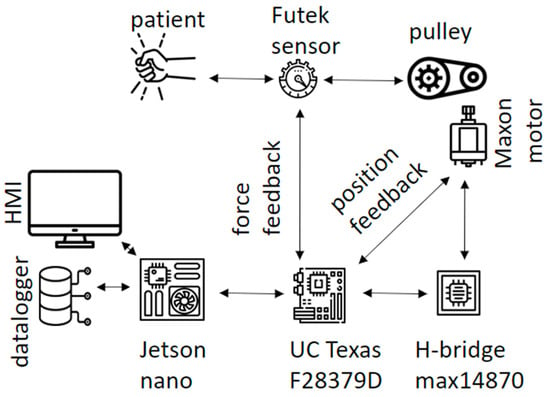
Figure 1.
Proposed general architecture. The prototype consists of two electronic cards. the Jetson nano sends the setpoint parameters selected in the interface to the microcontroller (UC) Texas F28379D, and stores the values generated by the controller and the sensors. The H-bride transforms the PWM signal generated by the UC into a voltage to move the motor. The interaction between the patient and the motor is detected by the Futek load cell sensor.
The patient’s hand is positioned inside the handle, which is made of a flexible textile for a comfortable grip. Figure 2 shows an image with all the components. The patients sit in a chair, and the described components are mounted in an aluminum structure that provides a comfortable workspace.
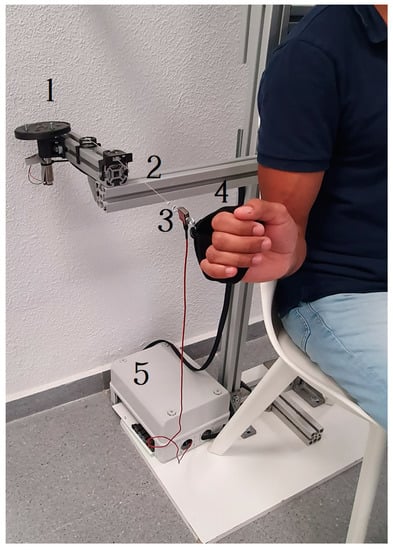
Figure 2.
Main components of the rehabilitation device: actuator (1), transmission components (2), force sensor (3), handle (4), and controller (5).
2.2. Control Algorithm Design
In this work, a force controller is proposed based on the cable tension exerted by the patient and an adaptive speed PI controller. The force sensor provides a range of detection from 0 N to 111 N; therefore, the maximum configurable payload of the prototype is 11.32 Kg. The proportional gain Kp is modified as a function of the ratio between the force error and the reference; the proposed values are shown in Figure 3. The integral gain Ki was set at a value of 2. Kp and Ki were tuned experimentally.
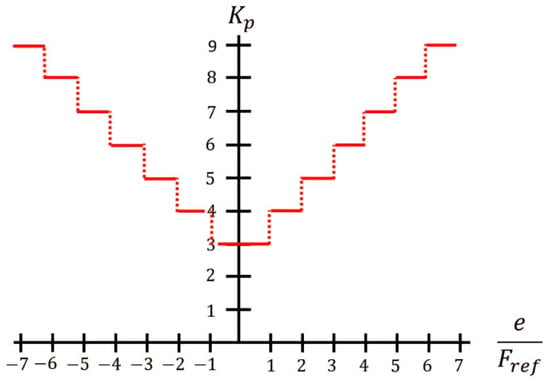
Figure 3.
Value of the gain Kp according to the ratio between the force error and the reference. When the ratio increases, a higher gain is applied. The minimum value is adjusted for the recovering cable.
2.3. Controller Performance
Some trials were performed in the laboratory to properly tune the controllers. Figure 4 shows the performance of the force exerted by the motor when applied to the reference. As we can see, the information provided by the force sensor oscillates around the reference. This oscillation is due to the interaction with the patient; the different movement speed is directly transformed to an incremental variation of the reflected force. This is the usual behavior of a force control loop that maintains a reflected force.
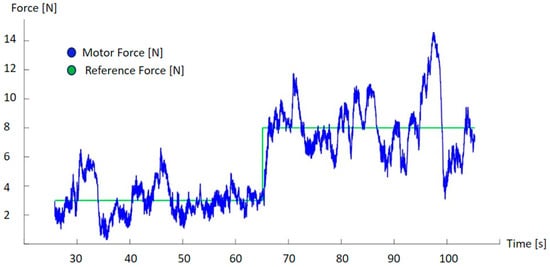
Figure 4.
Evolution of the force exerted by the motor according to the force reference. Oscillations over the reference are due to the interaction with the patient to account for differences in resistance during the movement.
2.4. Participants
The inclusion criteria established for the selection of patients were as follows: upper limb musculoskeletal injury, no pathology for which rehabilitation treatment is contraindicated, and over 18 years of age. Patients who met any of the following exclusion criteria were not admitted to the study: cognitive impairment that prevented the understanding of simple commands, neurological lesion affecting the upper extremity, dermatological lesion of the upper extremity preventing the use of device material, and/or any other type of injury impeding the use of the device.
This protocol was approved by the Research Ethics Committee of the Rey Juan Carlos University Institute. The ethical principles for medical research in humans from the Declaration of Helsinki were followed. All subjects signed the informed consent form prior to participation. Trials were carried out at the Getafe Clinical Centre (Madrid, Spain).
2.5. Intervention
The clinician adjusted the controller parameters for each patient according to the predefined exercise (in this case, the shoulder rotation movement). These parameters define the shoulder rotation range and the stress of the reflected force on the patient, which is in an interval of 5 N to 15 N. Furthermore, it was verified that the pulley was in the same plane as the patient’s forearm. This alignment makes movements more comfortable as the forces directly oppose shoulder rotation with no movement at the elbow.
Each session lasted 15 min and consisted of repeating a cycle of external rotation and internal rotation 30 times, returning to the starting position. These cycles were carried out with the patient sitting down, in a chair with a backrest, and with their feet on the floor. Initially, the arm was positioned close to the body with a 90° elbow flexion, and from this position, the rotation movements were performed. Figure 5 shows a patient during a session.
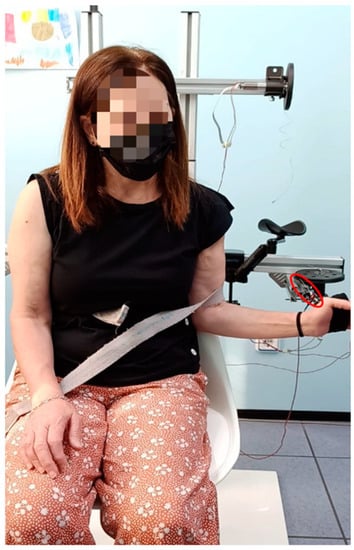
Figure 5.
Patient performing shoulder rotation in the horizontal plane. The patient pulls the cable by means of a tape held in her hand. The cable is circled in red.
To perform the rotation movements, the patient started the external rotation movement from the initial position up to the maximum rotation they were able to achieve. In this half-cycle, the patient exerted a force greater than that generated by the motor. In the second half of the cycle, when the patient returned to the initial position, performing an internal rotation; this movement was in the opposite direction and the force applied by the motor was greater than that exerted by the patient. Figure 6 shows the limits of the cyclical movement. The force reflected by the actuator was fixed throughout the cycle and measured by the load cell. This load cell was located close to the patient’s hand to obtain an accurate estimate of the force reflected on the patient; otherwise, the forces caused by friction might affect the information processed by the controller.
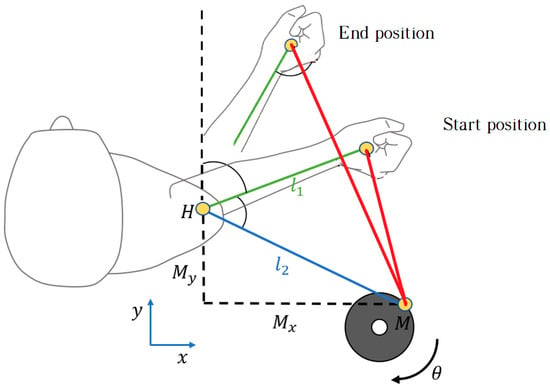
Figure 6.
Range of movement for horizontal shoulder rotation. The rehabilitation session consists of the repetition of movements from the starting position to the end position. The starting position is defined by the physician and the end position is set according to the evolution of the patient.
2.6. Outcome Measures
The range of motion (ROM) of external rotation was measured using a double-armed 360° goniometer. The patients were in a supine position with the humerus abducted at 90° and the elbow flexed at 90°. Measurements were performed twice and averaged for further analysis [12].
The system usability scale (SUS) was used to assess patient satisfaction with the device. This questionnaire was developed by Brooke [13] as a usability tool and has been widely used in the evaluation of a variety of systems. The SUS provides a quick and reliable tool for measuring the usability of a device. It is a simple and short questionnaire to answer; a final score is provided with an interpretation based on a well-established reference standard. It has excellent reliability (0.85). It consists of a 10-item questionnaire with five response options, from strongly agree (score of 5) to strongly disagree (score of 1). There are five positive and five negative statements, which are presented in alternatingly. The odd-numbered questions (Q1 “I think I would use this device frequently’, Q3 “I think the device was easy to use’, Q5 “The functions of this device are well integrated’, Q7 “I imagine that most people would learn to use this device very quickly’, and Q9 “I feel safe using this device’) are positive questions, and the recorded scores are the original scores subtracted by 1. The even-numbered questions (Q2 “I find this device unnecessarily complex’, Q4 “I think I would need help from a person with technical knowledge to be able to use this device’, Q6 “I think the device has a lack of consistency’, Q8 “I find the device very difficult to use’, and Q10 “I needed to learn many things before able to use this device”) are negative questions with recorded scores being subtracted from 5. Once the results for the ten questions are treated, the score of each question is added, and the result is multiplied by a factor of 2.5. The SUS score, therefore, ranges from 0 to 100, where a higher score means better usability, with a threshold of 68 to establish the usability of the device [14].
2.7. Statistical Analysis
Statistical analysis was performed using the SSPS statistical software system (SSPS Inc., Chicago, IL, USA; version 27.0). A descriptive analysis of all the variables was performed. The results were expressed as average and standard deviation and median and interquartile range. The normal distribution of the variables was verified using the Shapiro–Wilk test. The hypothesis that the variables did not have a normal distribution was accepted, given the results of this test, the verification of each variable’s histograms, and the sample size. We used the Wilcoxon test, a nonparametric test for related samples. Statistical analysis was performed with a confidence level of 95%, and therefore significant values were those whose p was < 0.05.
3. Results
The sample consisted of 12 shoulder rehabilitation sessions with 11 patients (n = 11) (5 men and 6 women) with different shoulder pathologies that limited their range of shoulder mobility. In one of the patients, both shoulders were treated. One patient performed two sessions for the rehabilitation of both shoulders, while the rest performed only one rehabilitation session. The ages ranged from 35 to 66 years (54.92 ± 3.16 years). Table 1 shows the data of the patients who participated in the testing of the device.

Table 1.
Data of patients that tested the device. S11 and S12 were performed by the same patient, but with different shoulders (left and right, respectively).
The analysis shows statistically significant changes for the ROM of external shoulder rotations. The mean and standard deviations of the external rotation of shoulder were 42.91 ± 4.53° for the pre-intervention measurements and 53.88 ± 4.26° for the post-intervention measurements. Figure 7 and Table 2 show the data and range of movement of the patients during the rehabilitation sessions.
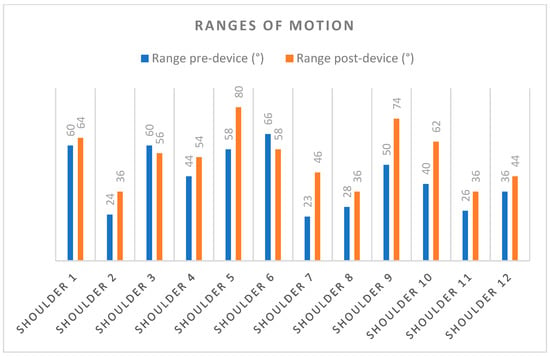
Figure 7.
Ranges of motion after one rehabilitation session. A total of 10 out of 12 shoulders present improvements, while 2 present slight deteriorations, likely due to lack of familiarity with the device.

Table 2.
Comparison of range of motion of shoulder external rotations.
The patient scores on the SUS questionnaire ranged from 65 to 97.5, with an average score of 82.70 ± 9.21, suggesting a high degree of acceptance. These scores are higher than 68, indicating that this device can be rated “excellent” in the acceptability range. Table 3 shows the means of the scores obtained for each question. Questions Q1, 3, 5, 7, and 9 were positive questions and the averages obtained in these questions were above 4. It is worth noting that Q1 “I think I would use this device frequently” presented an average score of 4.75 ± 0.59 and Q9 “I feel safe using this device” showed an average score of 4.91 ± 0.27. Meanwhile, questions Q2, 4, 6, 8, and 10 were negative questions. The mean scores in these questions were 1, except in Q2 “I find this device unnecessarily complex” which had a mean score of 2.5 ± 1.55 and Q4 “I think I would need help from a person with technical knowledge to be able to use this device” with a mean score of 2.91 ± 1.49.

Table 3.
Results of the system usability scale questionnaire.
4. Discussion
The present study showed the use of an active device for shoulder rehabilitation based on a force control architecture. This preliminary study is based on a single treatment session to treat the external rotation movements of the shoulder in the patients in whom this was limited by musculoskeletal injuries. It also described the patient’s acceptance of the device, and the results show a high level of approval from the patients after the first trial.
It has been demonstrated that robotic and haptic technologies, such as force control and real-time signal processing, have an effective contribution in upper limb rehabilitation. There are many examples of complex exoskeletons [15,16] and robot-like equipment applied in upper limb rehabilitation [17]. Physical therapy can be a long, lengthy, and costly process, which can lead to loss of interest in individuals undergoing therapy. Reducing recovery time is a potential solution that may motivate individuals to participate and continue physical therapy. Rehabilitation with an exoskeleton can reach more patients while reducing physician interactions and overall rehabilitation costs [18].
This equipment can perform a wide variety of movements but is specifically programmed for executing rehabilitation tasks. It is also necessary to design the proper patient interface to fix or attach the patient’s upper limb to the robot structure. These kinds of solutions have the advantage of being able to adapt to different rehabilitation activities. Cost-effective automation devices, such as exoskeletons, are critical to the success of these interventions and rehabilitation programs.
With a single treatment session, this active device for shoulder rehabilitation based on force control was found to significantly increase the external rotation movement of the shoulder in the patients who used it. The pre-intervention mean and standard deviations of the ROM of the external rotation of the shoulder were 42.91 ± 4.53°, and 53.88 ± 4.26° in the post-intervention measurements. In addition, patients reported high levels of acceptance of the device; their scores on the SUS questionnaire ranged from 65 to 97.5, with an average score of 82.70 ± 9.21, indicating a high degree of acceptance. These very promising results were obtained with minimal hardware and a user-friendly interaction with the patient.
This device is in line with a new generation of compact and simple rehabilitation equipment that is portable and easy to use for the patient [19], in contrast to the classical robotic solutions mentioned above. The main advantage of this kind of solution is the simplicity and cost-effective aspects. Only one degree of freedom is enough to perform shoulder rehabilitation, and this equipment can be adapted for horizontal and vertical rotations. Moreover, the reduced size of the device allows it to be easily transported to the rehabilitation workspace, which can be located in a clinic or at the patient’s home.
This prototype is currently being improved in order to provide more functionalities to clinicians for performing new rehabilitation exercises and software is also being developed to better characterize the rehabilitation sessions.
5. Study Limitations
This study has several limitations. First, the small sample size cannot allow extrapolation of the results. Second, the ROM was evaluated with a manual goniometer. Futures studies are necessary using objective measures such as using a electrogoniometer or 3D motion analysis. Third, the sample was heterogeneous in respect to the injury and age. It is necessary to take this into account. Finally, the lack of follow-up does not allow us to conclude if the ROM improvement lasted over time.
6. Conclusions
In this paper, a compact and cost-effective prototype for shoulder rehabilitation was described. The most important features are the simplicity of the hardware and its effectiveness in rehabilitation exercises. The equipment is designed to repeat a shoulder rotation while reflecting a force on the patient’s hand. This exercise allows muscle activation, while also increasing the range of shoulder movement.
This device allows patients to perform exercises for rehabilitation sessions that are an ideal complement to clinician manipulation. The preliminary results suggest that the use of this device and the incorporation of such equipment into rehabilitation services could be of great help for patients in their rehabilitation process and for physiotherapists in applying their therapies.
Author Contributions
Conceptualization, all authors; methodology, all authors; rehabilitation device design and development, David Pont-Esteban, J.C., P.E., M.F. and M.A.S.-U.; clinical validation, A.C.-G. and I.M.A.-D.; writing—review and editing, all authors. All authors have read and agreed to the published version of the manuscript.
Funding
This research did not receive external funding.
Institutional Review Board Statement
The study was carried out in accordance with the Declaration of Helsinki and approved by the Ethics Committee of the Universidad Rey Juan Carlos (N-20130081).
Informed Consent Statement
Informed consent was obtained from all subjects involved in the study.
Acknowledgments
The authors thank all the patients and clinicians who participated in the validation test of the exoskeleton.
Conflicts of Interest
The authors declare that they have no conflict of interest.
References
- Lädermann, A.; Denard, P.J.; Collin, P. Massive rotator cuff tears: Definition and treatment. Int. Orthop. (SICOT) 2015, 39, 2403–2414. [Google Scholar] [CrossRef] [PubMed]
- Abdulla, S.Y.; Southerst, D.; Cote, P.; Shearer, H.M.; Sutton, D.; Randhawa, K.; Varatharajan, S.; Wong, J.J.; Yu, H.; Marchand, A.A.; et al. Is exercise effective for the management of subacromial impingement syndrome and other soft tissue injuries of the shoulder? A systematic review by the Ontario Protocol for Traffic Injury Management (OPTIMa) Collaboration. Man. Ther. 2015, 20, 646–656. [Google Scholar] [CrossRef] [PubMed]
- Lowry, V.; Lavigne, P.; Zidarov, D.; Perreault, K.; Roy, J.S.; Desmeules, F. Knowledge and appropriateness of care of family physicians and physiotherapists in the management of shoulder pain: A survey study in the province of Quebec, Canada. BMC Prim. Care 2023, 24, 49. [Google Scholar] [CrossRef] [PubMed]
- Deslauriers, S.; Déry, J.; Proulx, K.; Laliberté, M.; Desmeules, F.; Feldman, D.E.; Perreault, K. Effects of waiting for outpatient physiotherapy services in persons with musculoskeletal disorders: A systematic review. Disabil. Rehabil. 2021, 43, 611–620. [Google Scholar] [CrossRef] [PubMed]
- Ahmed, T.; Islam Md, R.; Brahmi, B.; Habibur Rahman, M. Robustness and Tracking Performance Evaluation of PID Motion Control of 7 DoF Anthropomorphic Exoskeleton Robot Assisted Upper Limb Rehabilitation. Sensors 2022, 22, 3747. [Google Scholar] [CrossRef] [PubMed]
- Suárez Sanabria, N.; Osorio Patiño, A.M. Biomecánica del hombro y bases fisiológicas de los ejercicios de Codman. Rev. CES Med. 2013, 27, 205–217. [Google Scholar]
- Teasell, R.; McIntyre, A.; Viana, R.; Bateman, E.A.; Murie-Fernandez, M.; Janzen, S.; Saikaley, M. Developing a framework for utilizing adjunct rehabilitation therapies in motor recovery of upper extremity post stroke. Top. Stroke Rehabil. 2023, 30, 493–500. [Google Scholar] [CrossRef] [PubMed]
- Wu, J.; Cheng, H.; Zhang, J.; Yang, S.; Cai, S. Robot-Assisted Therapy for Upper Extremity Motor Impairment After Stroke: A Systematic Review and Meta-Analysis. Phys. Ther. 2021, 101, pzab010. [Google Scholar] [CrossRef] [PubMed]
- Proietti, T.; Ambrosini, E.; Pedrocchi, A.; Micera, S. Wearable Robotics for Impaired Upper-Limb Assistance and Rehabilitation: State of the Art and Future Perspectives. IEEE Access 2022, 10, 106117–106134. [Google Scholar] [CrossRef]
- Podobnik, J.; Mihelj, M.; Munih, M. Upper limb and grasp rehabilitation and evaluation of stroke patients using HenRiE device. In Proceedings of the 2009 Virtual Rehabilitation International Conference, Haifa, Israel, 29 June–2 July 2009; pp. 173–178. [Google Scholar] [CrossRef]
- Zhao, Y.; Wu, H.; Zhang, M.; Mao, J.; Todoh, M. Design methodology of portable upper limb exoskeletons for people with strokes. Front. Neurosci. 2023, 17, 1128332. [Google Scholar] [CrossRef] [PubMed]
- Norkin, C.; White, D.J. Manual de Goniometría. In Evaluación de la Movilidad Articular, 5th ed.; Editorial Paidotribo: Barcelona, Italy, 2019. [Google Scholar]
- Brooke, J. SUS-A quick and dirty usability scale. Usability Eval. Ind. 1996, 189, 4–7. [Google Scholar]
- Brooke, J. SUS: A retrospective. J. Usability Stud. 2013, 8, 29–40. [Google Scholar]
- Kadivar, Z.; Beck, C.E.; Rovekamp, R.N.; O’Malley, M.K. Single limb cable driven wearable robotic device for upper extremity movement support after traumatic brain injury. J. Rehabil. Assist. Technol Eng. 2021, 8, 20556683211002448. [Google Scholar] [CrossRef] [PubMed]
- Gupta, S.; Agrawal, A.; Singla, E. Architectural design and development of an upper-limb rehabilitation device: A modular synthesis approach. Disabil. Rehabil. Assist. Technol. 2022. [Google Scholar] [CrossRef] [PubMed]
- Hailey, R.O.; De Oliveira, A.C.; Ghonasgi, K.; Whitford, B.; Lee, R.K.; Rose, C.G.; Deshpande, A.D. Impact of Gravity Compensation on Upper Extremity Movements in Harmony Exoskeleton. In Proceedings of the 2022 International Conference on Rehabilitation Robotics (ICORR), Rotterdam, The Netherlands, 25–29 July 2022; pp. 1–6. [Google Scholar] [CrossRef]
- Delgado, P.; Yihun, Y. Integration of Task-Based Exoskeleton with an Assist-as-Needed Algorithm for Patient-Centered Elbow Rehabilitation. Sensors 2023, 23, 2460. [Google Scholar] [CrossRef] [PubMed]
- Garzo, A.; Jung, J.H.; Arcas-Ruiz-Ruano, J.; Perry, J.C.; Keller, T. ArmAssist: A Telerehabilitation Solution for Upper-Limb Rehabilitation at Home. IEEE Robot. Autom. Mag. 2003, 30, 62–71. [Google Scholar] [CrossRef]
Disclaimer/Publisher’s Note: The statements, opinions and data contained in all publications are solely those of the individual author(s) and contributor(s) and not of MDPI and/or the editor(s). MDPI and/or the editor(s) disclaim responsibility for any injury to people or property resulting from any ideas, methods, instructions or products referred to in the content. |
© 2023 by the authors. Licensee MDPI, Basel, Switzerland. This article is an open access article distributed under the terms and conditions of the Creative Commons Attribution (CC BY) license (https://creativecommons.org/licenses/by/4.0/).